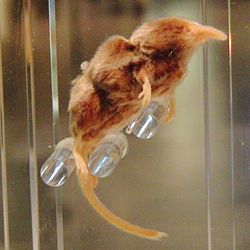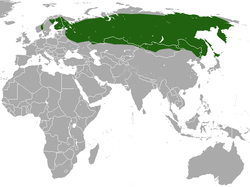Distribution
The Eurasian least shrew inhabits the northern taiga region, and is found throughout Siberia, in northern Europe (Finland, northern Sweden and parts of Norway) and on the islands of Sakhalin and Hokkaidō. It can be found in diverse habitats, including both coniferous and deciduous forests, open fields, and the edges of bogs. The population density appears to be fairly low throughout, though its prevalence may be underestimated in surveys since its small size lets it escape many commonly used traps.
Behavior
Due to its small size and reclusive habits, the Eurasian least shrew can be difficult to spot. Like shrews in general, the Eurasian least shrew mainly eats insects, but will also dine on carrion or any other source of protein it finds. In winter, it may occasionally seek food indoors. Because of its small size for a mammal, the Eurasian least shrew has an extremely high metabolic rate and must eat frequently to avoid starvation; in captivity it has been reported to eat 120 meals a day, consuming three to four times its own weight each day. The Eurasian least shrew is active around the clock, with occasional sleep periods of 10–50 minutes each.
The Eurasian least shrew can swim well, and in captivity even seems to enjoy playing in water. Its small size also makes the Eurasian least shrew a phenomenal climber: it has been observed climbing up even the smooth inside corner of a glass terrarium. Its eyesight is poor, but it has very good hearing. While the Eurasian least shrew frequently emits sounds, much of its communication is in frequencies beyond the limits of human hearing.
This page is based on this
Wikipedia article Text is available under the
CC BY-SA 4.0 license; additional terms may apply.
Images, videos and audio are available under their respective licenses.


